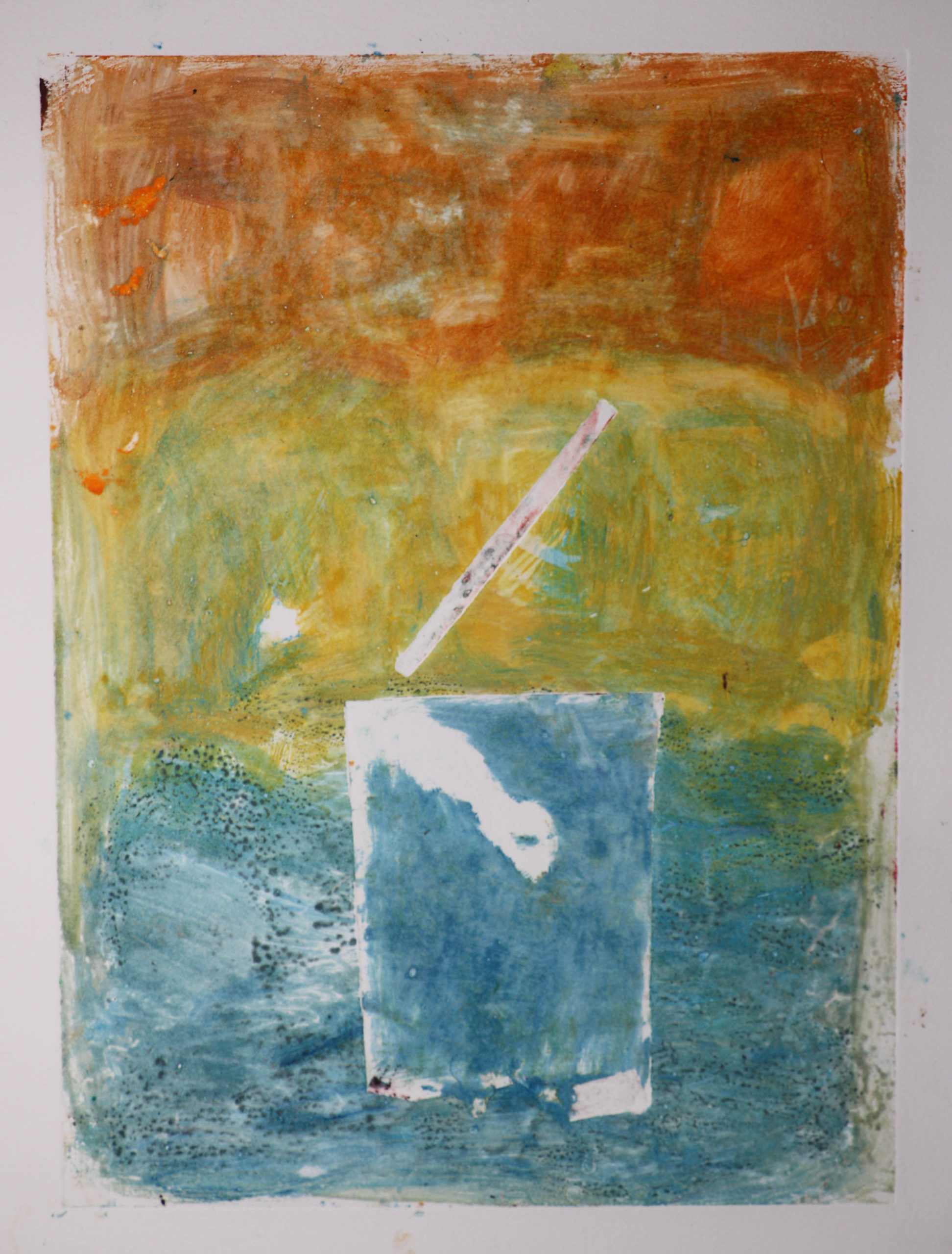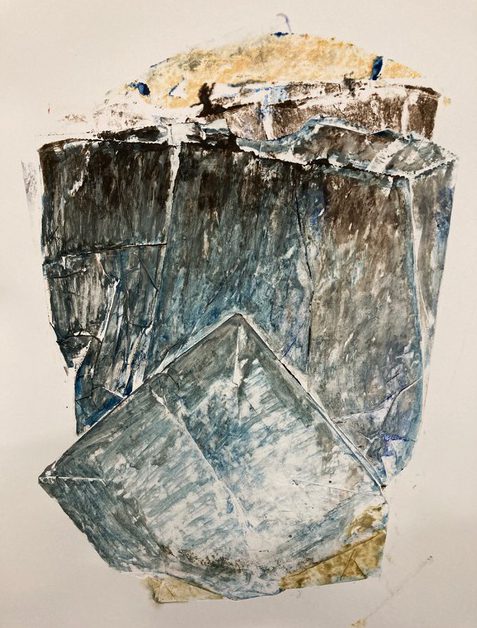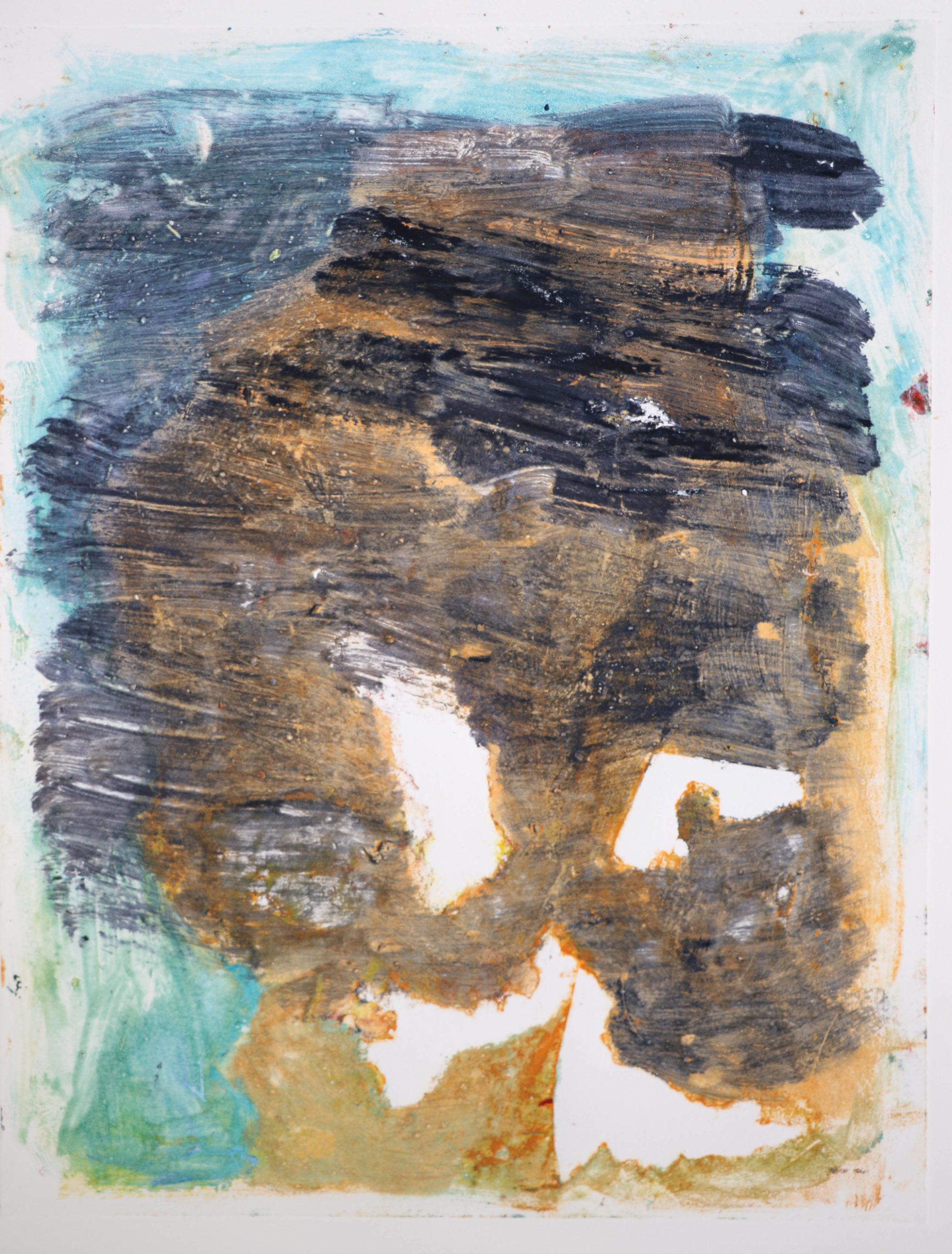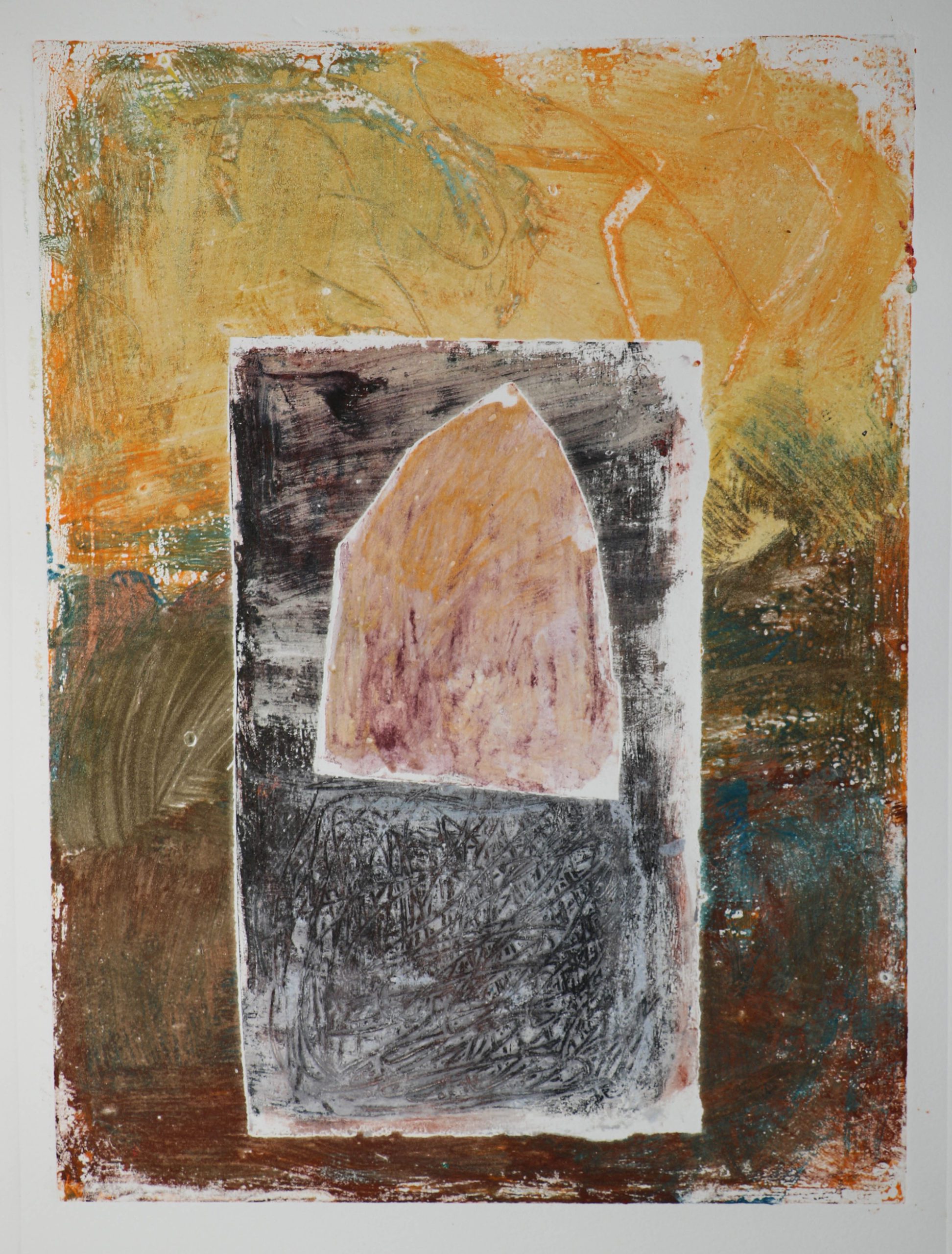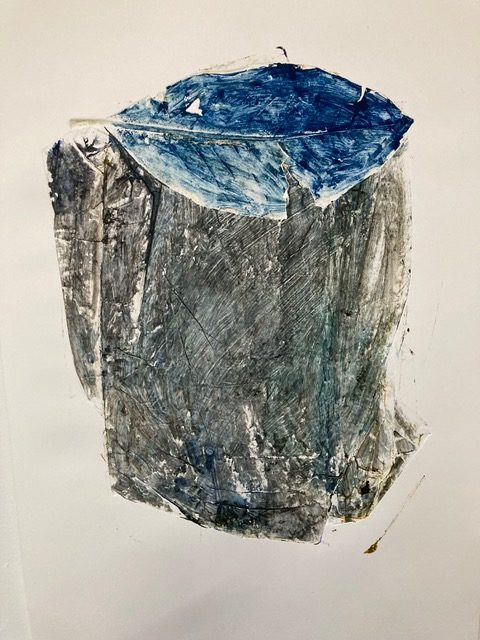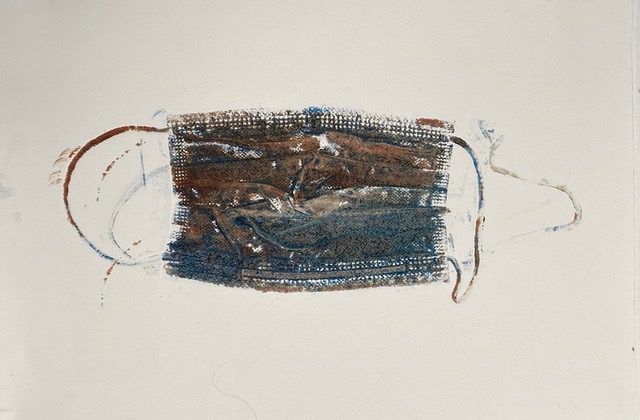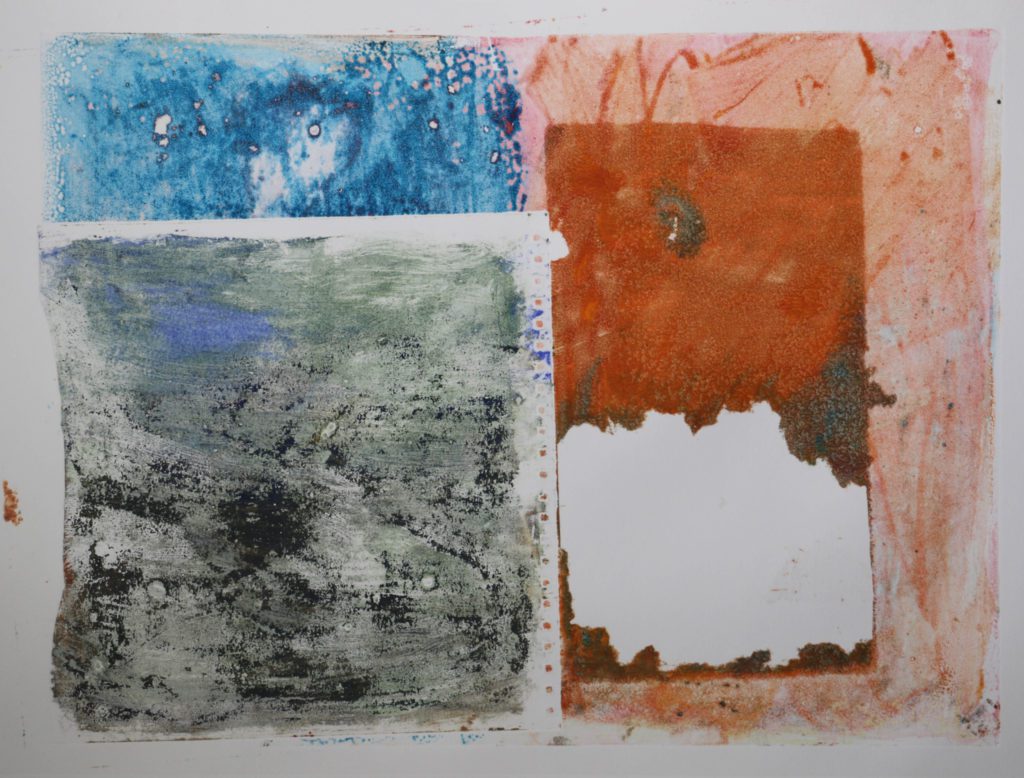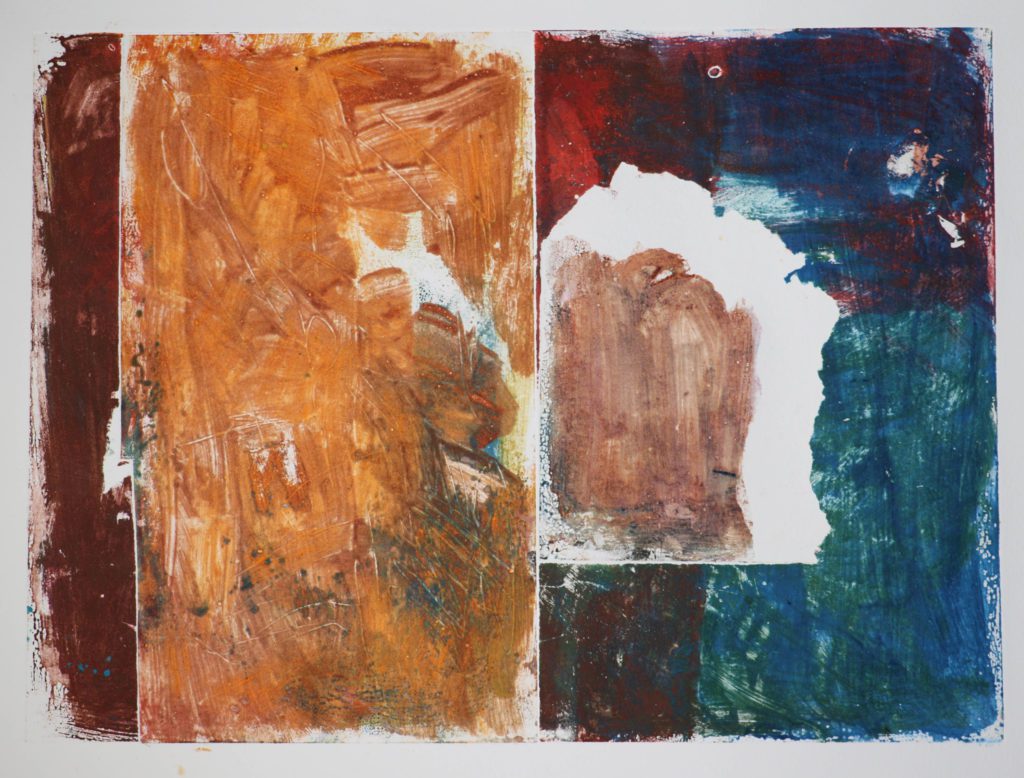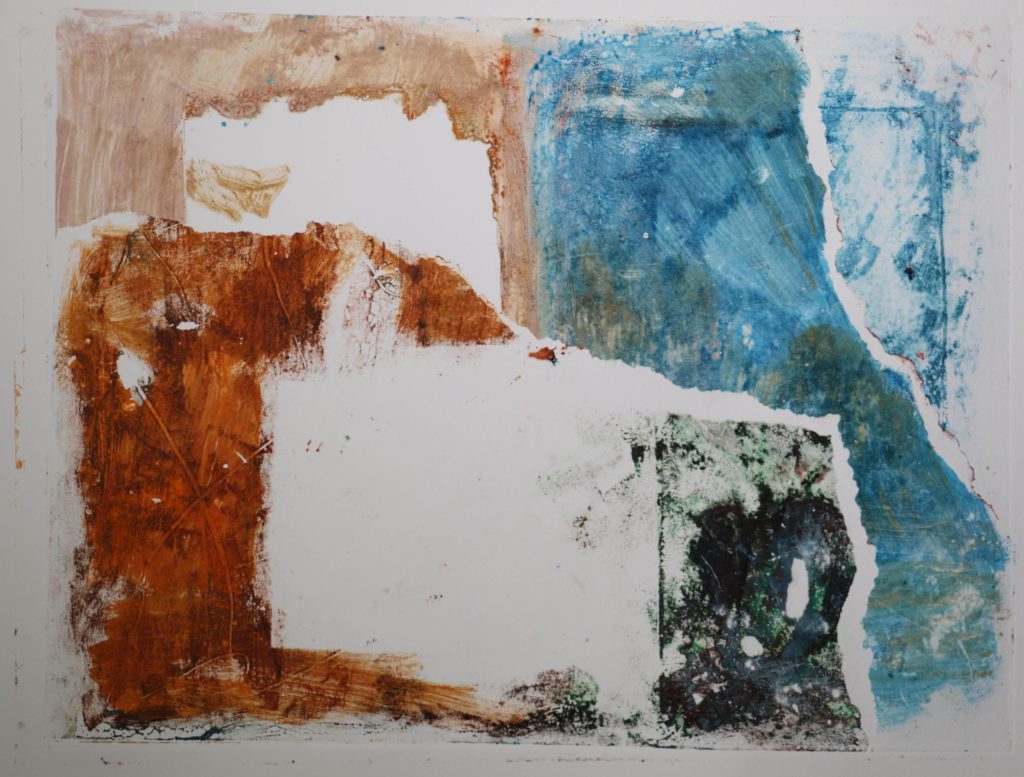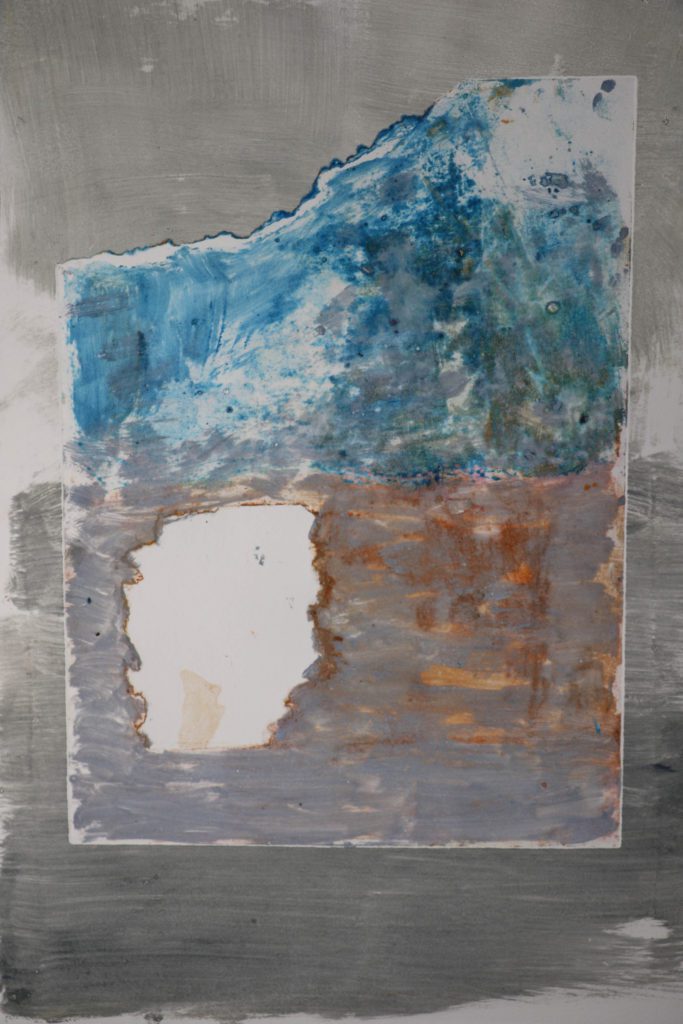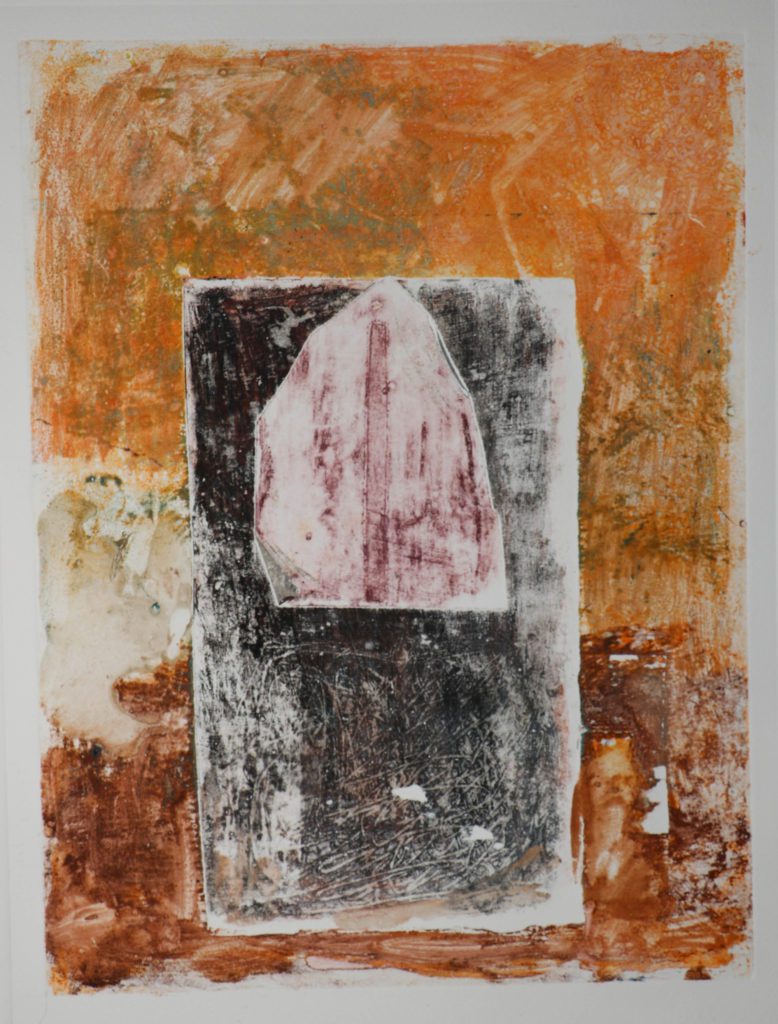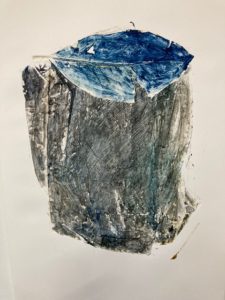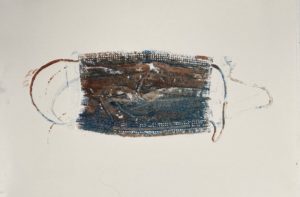Artist’s Focus
West
Space—vast, endless, personal, intimate—permeates my work. Oblique and haunting as well as curious or whimsical, the monotypes are landscapes offering divergent elements. They hold images suggesting questions rather than answers.
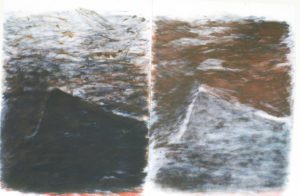
Mountain Wave, monotype
The western landscape, a big place with vague boundaries is my source for the West series. By visually wandering across a prairie, gazing at an expanse of mountains or observing the sky. I acknowledge a sense of spaciousness and immediacy. These sensations call for a focal reference. This may be something tangible or it may be internal. Both provide a meditative response.
I believe a duality of vision allows an acceptance of experience in an individual way. Agnes Martin suggested a similar concept, “It is from our awareness of transcendent reality and our response to concrete reality that our mind commands us on our way—not really a path or to a gate—but to a full response.” Walt Whitman wrote of the “strange mixture of delicacy” evident in the plains and mountains. David Smith spoke of the “rawness and harshness of the American landscape.”
The process of monotypes, a combination of painting, drawing and printmaking, and the consequent characteristics have suited my interest and visual language.
In all the monotypes in my West series, a paradox is present. An expanse is occupied by defined independent marks. Foggy ambiguous ground/atmosphere exist with strange, awkward rudiments. Borrowing from Jack Burnham in The Great Western Salt Works, these may be perceived as “signifiers.”
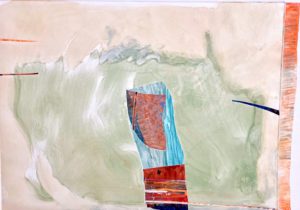
Untitled, monotype
Each work in the West series represents a syntax for divergent qualities. Each represent time—time of thought and time of action. They are my record of seeing. Richard Hugo expressed a similar thought in Open Country, “…And you come back here where the land has ways of going on and the shadow of a cloud crawls like a freighter, no port in mind…”
Northwest
Mountain Wave, a large piece I created many years ago relates to the symmetry and sublime power of mountains and oceans. I believe Mountain Wave was a premonition, pointing me to the Northwest many years later. In this piece, the elements are universal structures, symbols.
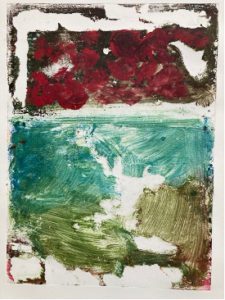
Untitled, monotype
In my studio in Portland, I find my palette is bolder, brighter, echoing colors and patterns, textures of towering cedars, carpets of moss and climbing vines. I’m discovering Pacific Northwest landscapes are intimate like the tide pools teeming with sea anemones or the rich Jory soil of Oregon. Weather changes daily, almost hourly. Rain mists and fog, giant clouds sailing across the sky, golden sunlight spreads across meadows, all framed by industrial buildings, steel bridges and busy highways.
West X Northwest
West X Northwest represents two places, just a thousand miles apart with distinct geographies.
Mountains and waves, suggesting places I have yet to discover.
West
Space—vast, endless, personal, intimate—permeates my work. Oblique and haunting as well as curious or whimsical, the monotypes are landscapes offering divergent elements. They hold images suggesting questions rather than answers.

Mountain Wave, monotype
The western landscape, a big place with vague boundaries is my source for the West series. By visually wandering across a prairie, gazing at an expanse of mountains or observing the sky. I acknowledge a sense of spaciousness and immediacy. These sensations call for a focal reference. This may be something tangible or it may be internal. Both provide a meditative response.
I believe a duality of vision allows an acceptance of experience in an individual way. Agnes Martin suggested a similar concept, “It is from our awareness of transcendent reality and our response to concrete reality that our mind commands us on our way—not really a path or to a gate—but to a full response.” Walt Whitman wrote of the “strange mixture of delicacy” evident in the plains and mountains. David Smith spoke of the “rawness and harshness of the American landscape.”
The process of monotypes, a combination of painting, drawing and printmaking, and the consequent characteristics have suited my interest and visual language.
In all the monotypes in my West series, a paradox is present. An expanse is occupied by defined independent marks. Foggy ambiguous ground/atmosphere exist with strange, awkward rudiments. Borrowing from Jack Burnham in The Great Western Salt Works, these may be perceived as “signifiers.”

Untitled, monotype
Each work in the West series represents a syntax for divergent qualities. Each represent time—time of thought and time of action. They are my record of seeing. Richard Hugo expressed a similar thought in Open Country, “…And you come back here where the land has ways of going on and the shadow of a cloud crawls like a freighter, no port in mind…”
Northwest
Mountain Wave, a large piece I created many years ago relates to the symmetry and sublime power of mountains and oceans. I believe Mountain Wave was a premonition, pointing me to the Northwest many years later. In this piece, the elements are universal structures, symbols.

Untitled, monotype
In my studio in Portland, I find my palette is bolder, brighter, echoing colors and patterns, textures of towering cedars, carpets of moss and climbing vines. I’m discovering Pacific Northwest landscapes are intimate like the tide pools teeming with sea anemones or the rich Jory soil of Oregon. Weather changes daily, almost hourly. Rain mists and fog, giant clouds sailing across the sky, golden sunlight spreads across meadows, all framed by industrial buildings, steel bridges and busy highways.
West X Northwest
West X Northwest represents two places, just a thousand miles apart with distinct geographies.
Mountains and waves, suggesting places I have yet to discover.
Events
-
Open Studios + Holiday Market
Sunday, Dec. 4, 10 a.m.-4 p.m.
NW Maritime Art Works, 50+ artists
-
Interview
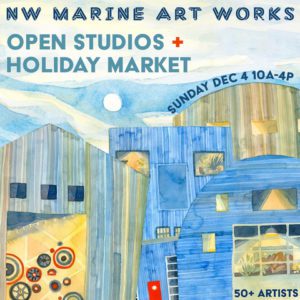
About Lynda
I am a Westerner, growing up as a child on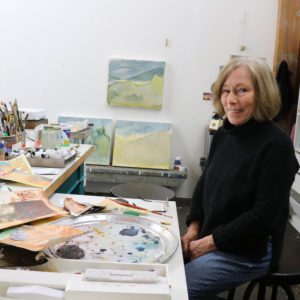 the Wyoming prairie. One of my earliest memories is being warned: “Don’t let the wind blow you away like a tumbleweed!” From Wyoming my family moved to Nebraska, Michigan and Missouri. My western roots and love of landscape brought me to Montana—in Billings and Paradise Valley—and now to Portland Oregon and the Pacific Northwest.
the Wyoming prairie. One of my earliest memories is being warned: “Don’t let the wind blow you away like a tumbleweed!” From Wyoming my family moved to Nebraska, Michigan and Missouri. My western roots and love of landscape brought me to Montana—in Billings and Paradise Valley—and now to Portland Oregon and the Pacific Northwest.
Landscapes capture my imagination—open country—golden prairies and expansive horizons, powerful free flowing rivers, ragged and immense Rocky Mountains, the Cascades, sparkling tidal pools—the immensity of oceans.
The power of imagination and exploration combined with curiosity has guided my art as well as my professional work in museums, philanthropy and policy. I had the honor to represent Billings in the Montana State Senate for eight years and discovered my background as an artist, historian and writer enabled me to establish legacy legislation such as the Montana Women’s Murals in the state Capital.
My Portland studio is in the Northwest Marine Art Works where I am continuing to explore, create and share new work.

I am a Westerner, growing up as a child onthe Wyoming prairie. One of my earliest memories is being warned: “Don’t let the wind blow you away like a tumbleweed!” From Wyoming my family moved to Nebraska, Michigan and Missouri. My western roots and love of landscape brought me to Montana—in Billings and Paradise Valley—and now to Portland Oregon and the Pacific Northwest.
Landscapes capture my imagination—open country—golden prairies and expansive horizons, powerful free flowing rivers, ragged and immense Rocky Mountains, the Cascades, sparkling tidal pools—the immensity of oceans.
The power of imagination and exploration combined with curiosity has guided my art as well as my professional work in museums, philanthropy and policy. I had the honor to represent Billings in the Montana State Senate for eight years and discovered my background as an artist, historian and writer enabled me to establish legacy legislation such as the Montana Women’s Murals in the state Capital.
My Portland studio is in the Northwest Marine Art Works where I am continuing to explore, create and share new work.
Projects & Collaborations
A Montana Love Story:
Wag a tail, shake a Horn, Woof-woof, maa-a-ah!
By Lynda Bourque Moss and Illustrated by D.C. Ice
A Montana Love Story is a true adventure that opens when Nubbin, a scruffy little rescue dog and her side-kick Frosty the pygmy goat are left behind by their family. Mischief begins as soon as the family speeds away in a beat-up suburban to get to school and work. After spying the open ranch door and helping themselves to a tasty breakfast in the kitchen, Nubbin and Frosty embark on an exciting journey to visit Bucky, the handsome Labrador Retriever, Nubbin’s true Montana love!
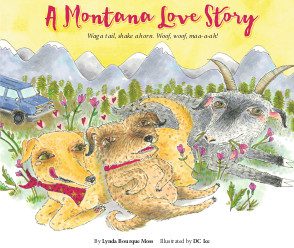 Set in Montana’s Mill Creek, deep in Paradise Valley at the foot of the Absaroka Beartooth Wilderness area, Nubbin and Frosty bravely go where they have never been before. Guided by a Great Horned Owl, Mr. Trout, Mother Fox and her Kits, Madame Marmot, Mountain Blue Birds and a Crow, Nubbin and Frosty face danger in wilderness and risk their lives in the fast-moving Mill Creek. After a long day’s journey and a forlorn night in the wild, Nubbin and Frosty find their way to Bucky’s home, and everyone wonders, “How did they find their way?”
Set in Montana’s Mill Creek, deep in Paradise Valley at the foot of the Absaroka Beartooth Wilderness area, Nubbin and Frosty bravely go where they have never been before. Guided by a Great Horned Owl, Mr. Trout, Mother Fox and her Kits, Madame Marmot, Mountain Blue Birds and a Crow, Nubbin and Frosty face danger in wilderness and risk their lives in the fast-moving Mill Creek. After a long day’s journey and a forlorn night in the wild, Nubbin and Frosty find their way to Bucky’s home, and everyone wonders, “How did they find their way?”
A Montana Love Story includes a map of Mill Creek with clues about Nubbin and Frosty’s journey. Author notes describe the background story of family friends, the humans who made the adventure possible. Included are questions to ponder such as how do animals find their way without maps, what happens when you are left behind or are animal friendships like ours? The storyline and illustrations evolved from conversations and information from friends and family, children’s librarians, botanists, biologists and elementary teachers. Several children and teens were eager readers and avid critics of the many, many draft manuscripts.
Copies of A Montana Love Story can be purchased by contacting lyndamoss@mac.com.
A Montana Love Story:
Wag a tail, shake a Horn, Woof-woof, maa-a-ah!
By Lynda Bourque Moss and Illustrated by D.C. Ice
A Montana Love Story is a true adventure that opens when Nubbin, a scruffy little rescue dog and her side-kick Frosty the pygmy goat are left behind by their family. Mischief begins as soon as the family speeds away in a beat-up suburban to get to school and work. After spying the open ranch door and helping themselves to a tasty breakfast in the kitchen, Nubbin and Frosty embark on an exciting journey to visit Bucky, the handsome Labrador Retriever, Nubbin’s true Montana love!
 Set in Montana’s Mill Creek, deep in Paradise Valley at the foot of the Absaroka Beartooth Wilderness area, Nubbin and Frosty bravely go where they have never been before. Guided by a Great Horned Owl, Mr. Trout, Mother Fox and her Kits, Madame Marmot, Mountain Blue Birds and a Crow, Nubbin and Frosty face danger in wilderness and risk their lives in the fast-moving Mill Creek. After a long day’s journey and a forlorn night in the wild, Nubbin and Frosty find their way to Bucky’s home, and everyone wonders, “How did they find their way?”
Set in Montana’s Mill Creek, deep in Paradise Valley at the foot of the Absaroka Beartooth Wilderness area, Nubbin and Frosty bravely go where they have never been before. Guided by a Great Horned Owl, Mr. Trout, Mother Fox and her Kits, Madame Marmot, Mountain Blue Birds and a Crow, Nubbin and Frosty face danger in wilderness and risk their lives in the fast-moving Mill Creek. After a long day’s journey and a forlorn night in the wild, Nubbin and Frosty find their way to Bucky’s home, and everyone wonders, “How did they find their way?”
A Montana Love Story includes a map of Mill Creek with clues about Nubbin and Frosty’s journey. Author notes describe the background story of family friends, the humans who made the adventure possible. Included are questions to ponder such as how do animals find their way without maps, what happens when you are left behind or are animal friendships like ours? The storyline and illustrations evolved from conversations and information from friends and family, children’s librarians, botanists, biologists and elementary teachers. Several children and teens were eager readers and avid critics of the many, many draft manuscripts.
Copies of A Montana Love Story can be purchased by contacting lyndamoss@mac.com.
Monoprinting: Forever Evolving
Monotypes are an immediate and intimate form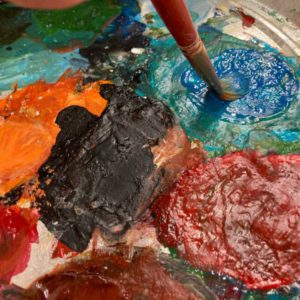 of printmaking. The process of monoprinting has been in use for centuries. In the Renaissance, artists including Baldassare Castaglione and Leonardo da Vinci, created one-of-a-kind prints, which they later enhanced by drawing or painting on the printed surface. William Blake explored monoprinting as a way of achieving unusual effects in his etchings, and Edgar Degas created monotypes as background for many of his pastel drawings.
of printmaking. The process of monoprinting has been in use for centuries. In the Renaissance, artists including Baldassare Castaglione and Leonardo da Vinci, created one-of-a-kind prints, which they later enhanced by drawing or painting on the printed surface. William Blake explored monoprinting as a way of achieving unusual effects in his etchings, and Edgar Degas created monotypes as background for many of his pastel drawings.
Monotypes are created by painting and drawing on a surface, and then transferring the image through a printing process to another surface, generally paper. A monotype is a singular art work. Jasper Johns created monotypes throughout his career and, like many artists, he included an endless variety of elements. He described the process as “playfulness, a light touch of materials.” Stencils, metal plates, flat stones, oil paints, etching inks, watercolors, graphite and found objects can be used. Johns even used a cookie wrapper in one of his works.
For simplicity, monoprints have shared images; whereas monotypes generally have a singular image.
Monoprinting: Forever Evolving
Monotypes are an immediate and intimate form of printmaking. The process of monoprinting has been in use for centuries. In the Renaissance, artists including Baldassare Castaglione and Leonardo da Vinci, created one-of-a-kind prints, which they later enhanced by drawing or painting on the printed surface. William Blake explored monoprinting as a way of achieving unusual effects in his etchings, and Edgar Degas created monotypes as background for many of his pastel drawings.
of printmaking. The process of monoprinting has been in use for centuries. In the Renaissance, artists including Baldassare Castaglione and Leonardo da Vinci, created one-of-a-kind prints, which they later enhanced by drawing or painting on the printed surface. William Blake explored monoprinting as a way of achieving unusual effects in his etchings, and Edgar Degas created monotypes as background for many of his pastel drawings.
Monotypes are created by painting and drawing on a surface, and then transferring the image through a printing process to another surface, generally paper. A monotype is a singular art work. Jasper Johns created monotypes throughout his career and, like many artists, he included an endless variety of elements. He described the process as “playfulness, a light touch of materials.” Stencils, metal plates, flat stones, oil paints, etching inks, watercolors, graphite and found objects can be used. Johns even used a cookie wrapper in one of his works.
For simplicity, monoprints have shared images; whereas monotypes generally have a singular image.
Client Love!
Visiting Lynda’s studio is like entering a wonderland of earth tones, texture and shape. Her monoprints are a must-see.
~ Jacqueline Sowell, attendee Portland Studio Tour 2022
Lynda is generous with her knowledge about monoprinting. Her views on the interstice of creativity, curiosity and imagination are compelling – and are on display in her work.
~ Lea Ann Easton, attendee Portland Studio Tour 2022
